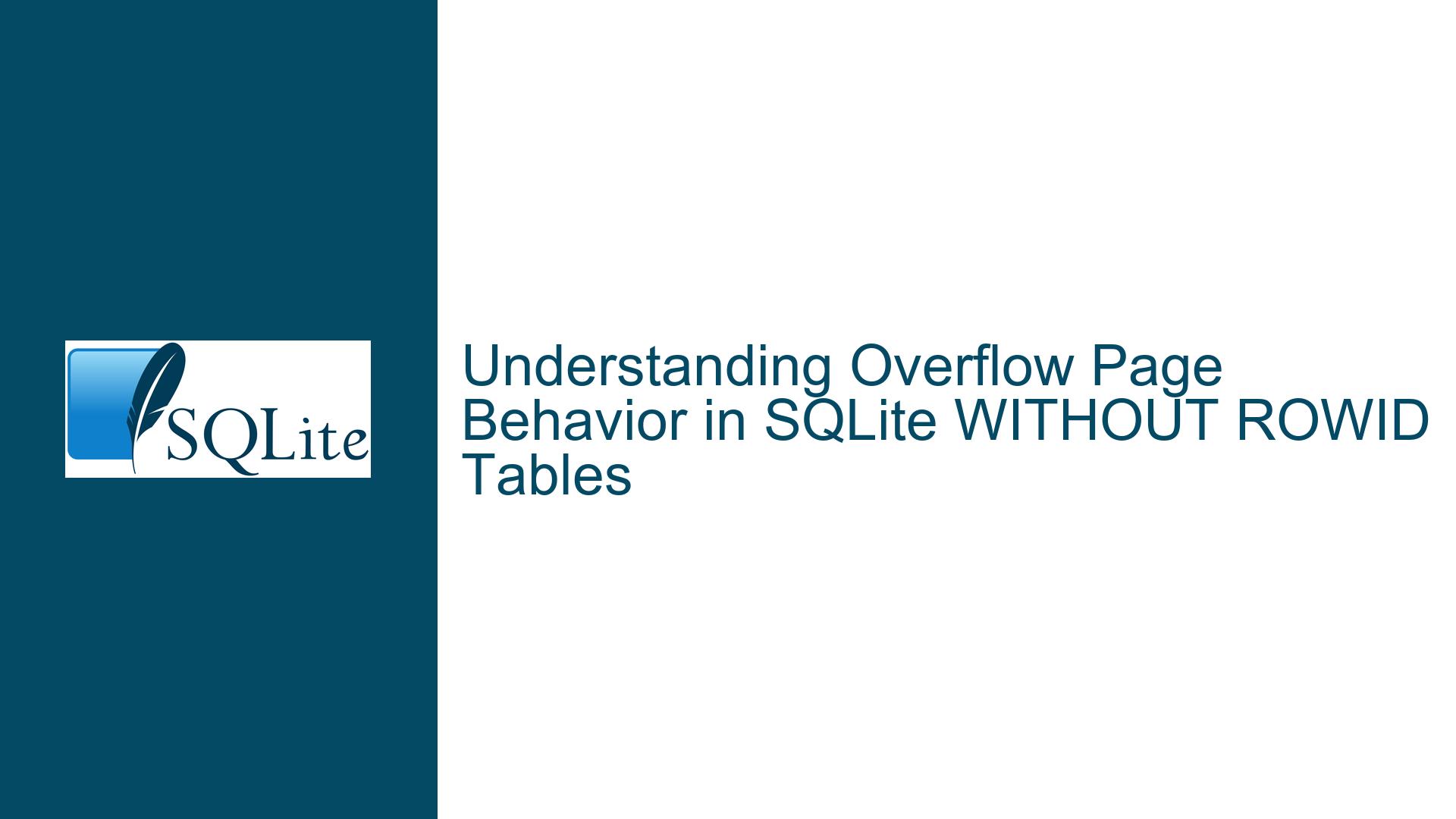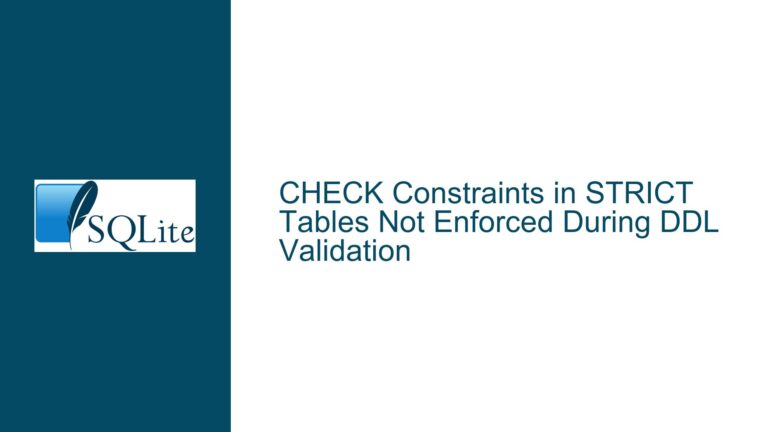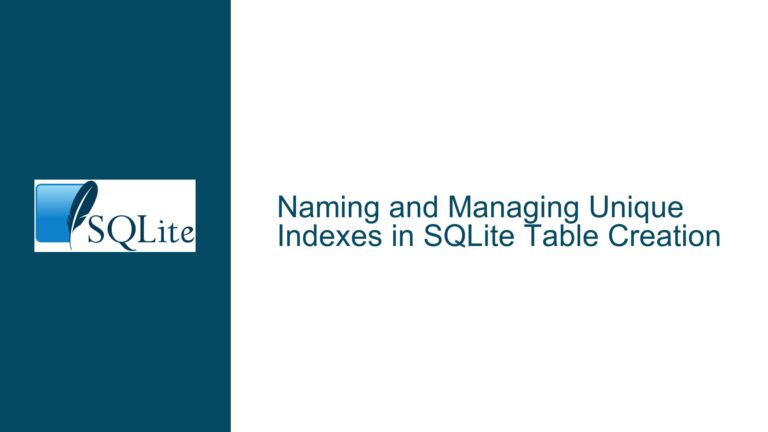Overflow Page Behavior in SQLite WITHOUT ROWID Tables
Issue Overview: Overflow Page Behavior in WITHOUT ROWID Tables
SQLite’s WITHOUT ROWID tables are a powerful feature that allows developers to create tables that are stored as a covering index, eliminating the need for a separate rowid column. This can lead to performance improvements in certain scenarios, particularly when dealing with tables that have a natural primary key. However, the storage format of WITHOUT ROWID tables differs significantly from regular tables, especially when it comes to handling large payloads such as BLOBs or large text fields.
In a regular table, the payload is stored directly in the leaf pages of the B-tree. This means that if a row contains a large BLOB, the entire BLOB is stored in the leaf page, potentially causing the page to split if the BLOB exceeds the page size. However, in a WITHOUT ROWID table, the storage format is more akin to that of an index. This means that the payload is subject to different constraints, particularly when it comes to overflow pages.
The key issue here is that in WITHOUT ROWID tables, the threshold for spilling data onto overflow pages is much lower than in regular tables. Specifically, if the payload exceeds 1/4 of the page size, it will be moved to an overflow page. This behavior is by design, as it ensures that the B-tree maintains a reasonable fan-out, preventing the tree from becoming too deep and thus maintaining performance. However, this design choice can lead to significant inefficiencies in storage, particularly when dealing with large payloads.
For example, consider a table with a page size of 4096 bytes. In a regular table, a BLOB that is 1200 bytes in size would be stored entirely in the leaf page, with no need for overflow pages. However, in a WITHOUT ROWID table, the same BLOB would be split across multiple pages, with the majority of the data being stored in overflow pages. This can lead to a significant increase in the size of the database, as each overflow page can only store data for a single row.
This behavior is particularly problematic when dealing with tables that contain a large number of rows with payloads that are just above the 1/4 page threshold. In such cases, the database size can grow significantly, as each row will require its own overflow page. This can lead to a situation where the database size is several times larger than it would be if the same data were stored in a regular table.
Possible Causes: Why Overflow Pages Behave Differently in WITHOUT ROWID Tables
The root cause of this behavior lies in the way WITHOUT ROWID tables are implemented in SQLite. As mentioned earlier, these tables are stored as a covering index, which means that they use the same storage format as an index. This has several implications for how data is stored and managed.
First, in a regular table, the B-tree is structured such that all content is stored in the leaf pages. This means that intermediate pages only contain keys, which are typically small integers. As a result, the fan-out of the tree is high, and the tree remains relatively shallow. However, in an index (and thus in a WITHOUT ROWID table), the keys can be arbitrarily large, and the content is stored in both intermediate and leaf pages. This means that the fan-out of the tree is lower, and the tree can become deeper if the keys are large.
To prevent the tree from becoming too deep, SQLite imposes a limit on the size of any single entry in an index. Specifically, no more than 1/4 of a page can be used for any single entry before it spills onto an overflow page. This ensures that the minimum fan-out of the tree is 4, which is necessary to maintain performance. However, this also means that the threshold for spilling data onto overflow pages is much lower in WITHOUT ROWID tables than in regular tables.
Another factor that contributes to this behavior is the way overflow pages are managed in SQLite. In a regular table, overflow pages can be shared between multiple rows, as long as the rows are stored on the same B-tree page. However, in a WITHOUT ROWID table, each overflow page can only store data for a single row. This means that if a table contains a large number of rows with payloads that are just above the 1/4 page threshold, each row will require its own overflow page, leading to a significant increase in the size of the database.
Finally, it’s worth noting that this behavior is not specific to BLOBs or large text fields. Any payload that exceeds the 1/4 page threshold will be subject to the same constraints. This means that even if a table contains a large number of small fields, the combined size of those fields could still trigger the use of overflow pages if they exceed the threshold.
Troubleshooting Steps, Solutions & Fixes: Managing Overflow Pages in WITHOUT ROWID Tables
Given the challenges associated with overflow pages in WITHOUT ROWID tables, it’s important to carefully consider whether this table type is the best choice for your specific use case. If you do decide to use a WITHOUT ROWID table, there are several strategies you can employ to mitigate the impact of overflow pages on your database size.
1. Evaluate the Need for WITHOUT ROWID: The first step in addressing this issue is to evaluate whether a WITHOUT ROWID table is truly necessary for your use case. In many cases, the performance benefits of using a WITHOUT ROWID table may be outweighed by the storage inefficiencies caused by overflow pages. If your table does not require the specific features of a WITHOUT ROWID table, consider using a regular table instead.
2. Optimize Payload Size: If you must use a WITHOUT ROWID table, consider optimizing the size of your payloads to avoid triggering the use of overflow pages. This could involve compressing large BLOBs or text fields, or splitting large fields into smaller chunks that can be stored within the 1/4 page threshold. By reducing the size of your payloads, you can minimize the number of overflow pages required and reduce the overall size of your database.
3. Adjust Page Size: Another strategy for managing overflow pages is to adjust the page size of your database. SQLite allows you to specify the page size when creating a new database, and this can have a significant impact on the behavior of overflow pages. For example, if you increase the page size to 8192 bytes, the 1/4 page threshold will also increase, potentially allowing you to store larger payloads without triggering the use of overflow pages. However, it’s important to note that increasing the page size can also have other implications for performance and storage, so this approach should be used with caution.
4. Use a Hybrid Approach: In some cases, it may be possible to use a hybrid approach that combines the benefits of WITHOUT ROWID tables with the storage efficiency of regular tables. For example, you could store the primary key and small fields in a WITHOUT ROWID table, while storing large BLOBs or text fields in a separate regular table. This approach allows you to take advantage of the performance benefits of WITHOUT ROWID tables while minimizing the impact of overflow pages on your database size.
5. Monitor and Analyze Database Size: Finally, it’s important to regularly monitor and analyze the size of your database to identify any potential issues with overflow pages. SQLite provides several tools for analyzing database size and storage efficiency, including the sqlite3_analyzer tool. By regularly analyzing your database, you can identify any tables or indexes that are consuming excessive storage due to overflow pages and take corrective action as needed.
In conclusion, while WITHOUT ROWID tables offer several performance benefits, they also come with unique challenges when it comes to managing overflow pages. By carefully evaluating your use case, optimizing payload size, adjusting page size, using a hybrid approach, and regularly monitoring your database, you can mitigate the impact of overflow pages and ensure that your database remains efficient and performant.






